Why should government be involved at all in our health care system? Aside from providing care for low-income families, the most persuasive argument is that in the absence of coercion people will have an incentive to be uninsured "free riders." In our society, people who choose not to pay for insurance know that they are likely to get health care anyway – even if they can't pay for it. The reason is that there is a tacit, widely shared agreement that no one will be allowed to go without care. As a result, the willfully uninsured impose external costs on others – through the higher taxes or higher prices which subsidize the cost of their care.
What evidence is there that free riders are a problem? One piece of evidence is the number of uninsured:
- According to the Census Bureau, in 1999 there were 42.6 million people who were uninsured at any one time, a larger percentage of the population than a decade ago.
- The rise in the number of uninsured has occurred during a time when per capita income and wealth, however measured, have been rising.
Although it is common to think of the uninsured as having low incomes, many families who lack insurance are solidly middle class. And the largest increase in the number of uninsured in recent years has occurred among higher-income families:
- About one in seven uninsured persons lives in a family with an income between $50,000 and $75,000, and almost one in six earns more than $75,000.
- Further, between 1993 and 1999, the bulk of the increase in the number of uninsured was among the households earning more than $50,000.
- By contrast, in households earning less than $50,000 the number of uninsured decreased by about 5 percent.
In deciding to be uninsured by choice, many healthy individuals are undoubtedly responding to perverse incentives created by government policies.
- On the one hand, we make an enormous amount of free care available to the uninsured; in Texas, for example, it totals $1,000 per uninsured person every year, on the average.
- Also, federal and state laws are making it increasingly easy for people to obtain insurance after they get sick – thus removing the incentive to buy insurance when they are healthy.
- Finally, although the federal government generously subsidizes employer-provided insurance, most of the uninsured are not eligible for an employer plan, and they get virtually no tax relief when they buy insurance on their own.
Far from solving the free rider problem, most government interventions these days are making the problem worse. Indeed, we might be better off under a policy of laissez faire.
If we accept the free rider argument, however, what policy implications logically follow from it? One commonly proposed solution is to have government require people to purchase insurance. However, this is neither necessary nor sufficient. Instead, a complete solution would have 10 characteristics. Adhering to each of them would lead to a system that provides a reasonable form of universal coverage for everyone without adding to national health care spending and without intrusive and unenforceable government mandates.
1. We should subsidize those who insure and penalize those who do not. Since we have a social interest in encouraging people to have health insurance, we should subsidize its purchase – say, with tax credits. The penalty for not being insured would be the absence of the subsidy. Why not simply require people to purchase insurance without any subsidy? Because the only practical way to enforce such a mandate is by fining people who disobey it. And, since a fine is a penalty, the absence of the penalty is a subsidy to those who purchase insurance. A penalty/subsidy system, in other words, is all the leverage that is needed or desired.
2. The subsidy for private insurance should equal the value society places on insuring individuals, at the margin. We should decide how much we care (in money terms) whether a person is insured, and that should determine the size of the subsidy/penalty.
3. The revealed social value of insurance is the amount we spend on free care for the uninsured. Since none of us is a mind reader, how do we know how much it's worth collectively to insure a given individual? If we are willing to take the political system as dispositive, it's the amount we expect to spend on free care if the person is uninsured.
4. The penalties paid by the uninsured should be used to compensate those who provide safety net care. What should be done with the penalties (extra taxes) paid by those who continue to elect to be uninsured? These funds should be made available to those who operate the health care safety net in the community where each uninsured person lives. In this way, the uninsured would help finance their own "free" care.
5. The subsidy for each newly insured should be funded by reducing the expected amount of spending on free care for that person. If every uninsured person suddenly obtained insurance, we would no longer need to fund our nation's very expensive health care safety net. Further, money that was previously funding the safety net could then be used to subsidize health insurance for the newly insured. In this way, people who cease being insured free up the funds that subsidize their choice. In general, as individuals move from uninsured to insured status, we should reduce safety net spending and use the newly freed-up money to help subsidize the newly acquired insurance.
6. Subsidies for being insured should be independent of how the insurance is purchased. The social value of insurance is independent of how it is purchased. Accordingly, the subsidies for private insurance should be the same, whether purchased individually or through an employer. On a level playing field, the role of the employer would be determined in the marketplace – not by tax law.
7. The optimal number of uninsured is not zero. The social goal is to reach a point at which the additional cost (in terms of subsidy) of the last person we induce to insure is equal to the additional benefit (in terms of the reduction in cost of free care). At this point, there will almost certainly be some people who remain uninsured by choice.
8. The principles of reform apply with equal force to all citizens, regardless of income. People who earn $100,000 a year can incur medical bills they cannot pay almost as easily as people who earn only $30,000. For that reason, the social interest in encouraging insurance is largely independent of income. Accordingly, health insurance subsidies should be independent of income.
9. Health insurance subsidies need not add to budgetary outlays. Getting all the incentives right may involve shifting around a lot of money by reducing subsidies that are currently too large and increasing subsidies that are too small. But there is no reason to believe our health care system spends too little money right now. Nor is it necessary to add new money in order to adhere to the 10 characteristics described herein.
10. The federal government's role should remain strictly financial. From an interest in encouraging catastrophic insurance, there is no social reason why government at any level should dictate the content of health insurance plans. Although federal subsidies for private insurance exceed $141 billion a year, currently the federal government places very few restrictions on the content of insurance plans. And except for certain portability requirements, federal law is silent about the conditions under which insurance is bought and sold. The federal role is largely a financial one. It should remain so.
[page]As we move into the 21st century, it is clear that we are living with a number of institutions that were not designed for the Information Age. One of these institutions is our health care system.
Virtually everyone agrees that the health care system needs reform. But what kind of reform? And what should be the role of government in a reformed health care system? These are questions this document seeks to answer.
[page]
Aside from the burden of providing charity care to the poor, is there any legitimate reason for government to care whether people have health insurance? Although many reasons have been offered, the main – and by far the most persuasive – argument is the "free rider" argument outlined below. Yet if this is the reason why government has a legitimate interest in the health insurance decisions of individuals, then the public policies we adopt must solve the problem. The most commonly proposed solution to the free rider problem is to have government require people to purchase insurance. Yet a government-imposed mandate is neither necessary nor sufficient. There is a better solution – one that limits the role of government and expands the choices open to every citizen.
"People who fail to insure are likely to get health care anyway – even if they can't pay for it."
The Free Rider Argument. The traditional argument for government intervention is that health insurance has social benefits, over and above the personal benefits to the person who chooses to insure. The reason is that people who fail to insure are likely to get health care anyway – even if they can't pay for it. And the reason for that is that the rest of the community is unwilling to allow the uninsured to go without health care, even if their lack of insurance is willful and negligent.
This set of circumstances creates opportunities for some people to be free riders on other people's generosity. In particular, free riders can choose not to pay insurance premiums and to spend the money on other consumption instead – confident that the community as a whole will provide them with care even if they cannot pay for it when they need it. In other words, being a free rider works. It works because there is a tacit community agreement that no one will be allowed to go without health care. And this tacit agreement is so established that it operates as a social contract that many people substitute for a private insurance contract.
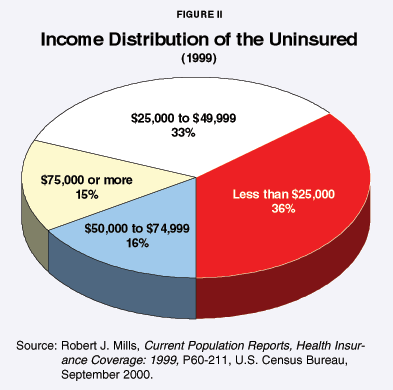
"More people are uninsured now than a decade ago."
Evidence of a Free Rider Problem: The Growing Number of Uninsured. What evidence is there that free riders are a problem? One piece of evidence is the number of uninsured:1
- According to the Census Bureau, in 1999 there were 42.6 million people who were uninsured at any one time, a larger percentage of the population than a decade ago [see Figure I].
- The rise in the number of uninsured has occurred during a time in which per capita income and wealth, however measured, have been rising.
Although it is common to think of the uninsured as having low-incomes, many families who lack insurance are solidly middle class [see Figure II]. And the largest increase in the number of uninsured in recent years has occurred among higher-income families:
- About one in seven uninsured persons lives in a family with an income between $50,000 and $75,000, and almost one in six earns more than $75,000.
- Further, between 1993 and 1999, the number of uninsured increased by 53 percent in households earning between $50,000 to $75,000 and by 85 percent among households earning $75,000 or more.
- By contrast, in households earning less than $50,000 the number of uninsured decreased approximately 5 percent.
More information about middle-class families who are voluntarily uninsured emerged from a recent California survey of the uninsured with incomes of more than 200 percent of poverty:2
- Forty percent owned their own homes and more than half owned a personal computer.
- Twenty percent worked for an employer that offered health benefits, but half of them (10 percent of the total) declined coverage for which they were eligible.
- However, this group was not opposed to insurance in general, as 90 percent had purchased auto, home or life insurance in the past.
- About 43 percent felt that health insurance was not a good value for the money, and rising insurance premiums will only increase this number.
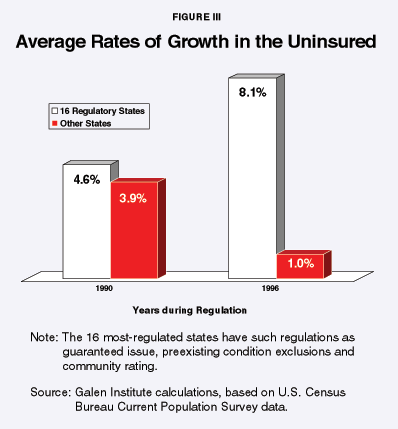
"Many families who are uninsured are middle-class."
These results are contrary to the normal expectation of economists. Economic theory teaches that as people earn higher incomes, they should be more willing to purchase insurance to protect their income against claims arising from expensive medical bills. Similarly, as people become wealthier the value of insuring against wealth depletion (say, by a catastrophic illness) also rises. So insurance should be positively correlated with income and wealth accumulation. The fact the number of uninsured rose while incomes were rising and that the greatest increase in lack of insurance was among higher-income families suggests that something else is happening to make insurance less attractive.
"The percentage of uninsured has grown faster in states with more regulations."
Cause of the Problem: Increasing State Regulation that Favors Free Ridership. A possible cause of the problem is the proliferation of state laws making it increasingly easy for people to obtain insurance after they get sick. Guaranteed issue regulations (requiring insurers to take all comers, regardless of health status) and community-rating regulations (requiring insurers to charge the same premium to all enrollees, regardless of health status) are a free rider's heaven. They encourage everyone to remain uninsured while healthy, confident that they will always be able to obtain insurance once they get sick.
Moreover, as healthy people respond to these incentives by electing to be uninsured, the premium that must be charged to cover costs for those who remain in insurance pools rises. These higher premiums, in turn, encourage even more healthy people to drop their coverage. Figure III shows the consequences numerically:3
- From 1990 through 1996, 16 states passed aggressive regulations to increase access to health insurance for people with health problems.
- These states experienced growth in their uninsured population eight times that of the states that did not.
Other regulations that raise the cost of insurance for the healthy exacerbate this condition. Among these are laws mandating coverage for such services as acupuncture, in vitro fertilization and even marriage counseling.4 For example:
- Duke University researchers showed that the probability an individual will become uninsured increases with each new mandate imposed by government.5
- A study for the Health Insurance Association of America (HIAA) found that 20 percent to 25 percent of uninsured Americans lack insurance due to benefit mandates.6
"Federal legislation has made it increasingly easy to obtain insurance after one gets sick."
Cause of the Problem: Federal Regulation That Favors Free Ridership. Federal legislation has also made it increasingly easy to obtain insurance after one gets sick. The Health Insurance Portability and Accountability Act of 1996 had noble intent: guarantee that people who have been paying premiums into the private insurance system do not lose coverage simply because they change jobs. But a side effect of pursuing this desirable goal is a provision that allows any small business to obtain insurance regardless of the health status of the employees. This means that a small, mom-and-pop operation can save money by remaining uninsured until a family member gets sick. Individuals can also opt out of their employer's plan, then enroll after they get sick. (They are entitled to full coverage for a preexisting condition after an 18-month waiting period.)7
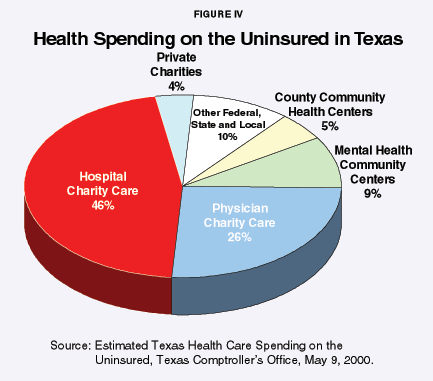
Cause of the Problem: National Spending on Indigent Health Care. Another piece of evidence is the amount we currently spend on free care for those who cannot or do not pay their medical bills. No one knows what the exact number is. However, public and private spending on free care is considerable. For example, a study by the State Comptroller's office found that Texas currently spends about $1,000 per year on free care for every uninsured person in the state, on the average [see Figure IV]. This implies that the value of "free" care is about $4,000 a year for a family of four.
Interestingly, $4,000 is a sum adequate to purchase private health insurance for a family in most Texas cities. Therefore, one way to look at the choice many Texas families face is: they can rely on $4,000 in free care (on the average) or they can purchase a $4,000 private insurance policy with after-tax income. Granted, the two alternatives are not exactly comparable. Families surely have more options if they have private insurance. But to many, the free care alternative appears more attractive.
"For many, relying on the safety net is more attractive than buying insurance."
Consequences of Free Ridership: An Increasingly Fragile Safety Net. As we shall see below, when people elect to move from a status of "uninsured" to "insured," say by enrolling in an employer's health plan, they receive a tax subsidy from the federal government. However, when people drop insurance coverage the federal government makes no extra contribution to any local health care safety net. As a consequence, the growth in the uninsured is straining the finances of many urban hospitals.
"For many, relying on the safety net is more attractive than buying insurance."
The problem is exacerbated by less generous federal reimbursement for Medicaid and Medicare and by increasing competitiveness in the hospital sector. Traditionally, hospitals have covered losses that arise from people who can't pay for their care by overcharging those who can. But as the market becomes more competitive, these overcharges are shrinking. There is no such thing as "cost shifting" in a competitive market.
There is ample evidence that this problem is not trivial. For example:
- Preliminary findings from a RAND study show that safety net spending by the nation's hospitals is not keeping pace with the overall increase in per capita spending.8
- A National Academy of Sciences Institute of Medicine study found that the safety net of local clinics, hospitals and charities is "overburdened and threadbare," and "could collapse with disastrous consequences."9
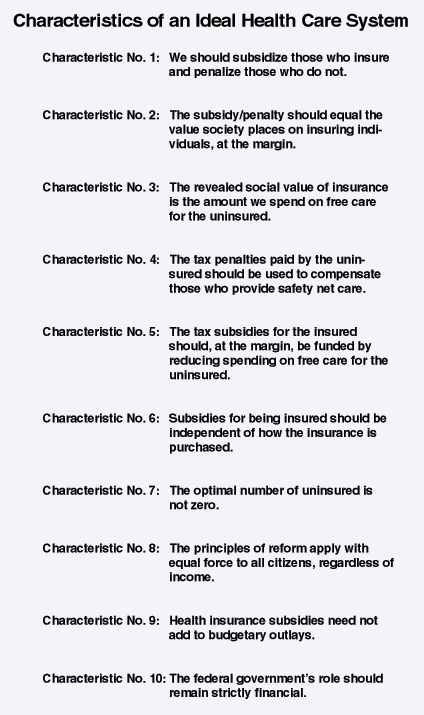
Fortunately, there is a better way. We can have a system that provides a reasonable form of universal coverage for everyone and does so without spending more money and without intrusive and unenforceable government mandates. Here's how.
Characteristic No. 1: We should subsidize those who insure and penalize those who do not.
To the advocates of mandates, we can always ask the question: What are you going to do with people who disobey the mandate? As a practical matter, no one is suggesting that we put them in jail. So we are left with imposing a financial penalty (e.g., a fine). But a system that fines people who are uninsured, ipso facto is a system that subsidizes those who insure – the subsidy being the absence of the fine.
"We should subsidize those who insure and penalize those who do not."
For example, under the current system families who obtain insurance through an employer obtain a tax subsidy worth about $1,155, on the average.10 Since an uninsured family with an average income doesn't get this subsidy, the uninsured family will pay about $1,155 more in taxes than families that have employer-provided insurance. So instead of describing our current system as one that subsidizes employer-provided insurance, we could, with equal validity, describe it as one that penalizes the lack of employer-provided insurance.
We can describe any incentive system in one of two ways: (1) as a system that grants subsidies to those who insure and withholds them from those who do not; or (2) as a system that penalizes the uninsured and refrains from penalizing the insured. Either description is valid, since a subsidy is simply the mirror image of a penalty.
Characteristic No. 2: The subsidy/penalty should equal the value society places on insuring individuals, at the margin.
"An ideal system would have 10 characteristics."
We should decide how much we care (in money terms) whether a person is insured and that should determine the size of the subsidy/penalty.11 Any other policy would be indefensible and absurd. It would entail spending too much on subsidies and collecting too much in fines, or vice versa. Under an ideal system: [See Sidebar]
- We should never pay more for (subsidize) good behavior than the good behavior's benefit to us, and we should never collect more from (penalize) bad behavior than its costs to us.
- Conversely, we should never pay less for good behavior than its benefit or penalize bad behavior less than its cost.
"Those with the highest incomes would get the largest subsidies under current law."
Current policy violates this principle in several ways. Although the average tax subsidy is worth about $1,155 per family, households earning more than $100,000 per year receive, on the average, $2,638 per year in subsidies. By contrast, those earning between $20,000 and $30,000 receive only $599. [See Figure V] One reason is that those earning higher incomes are in higher tax brackets. For example, a family in the 40 percent tax bracket gets a subsidy of 40 cents for every dollar spent on their health insurance. By contrast, a family in the 15 percent bracket gets a subsidy of only 15 cents on the dollar.
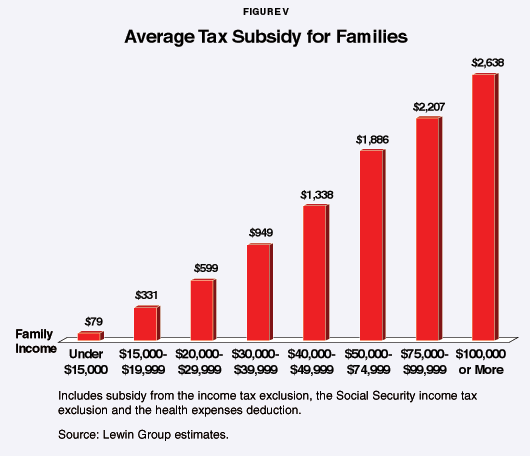
A uniform subsidy would offer the same tax reduction to everyone who obtains private insurance, and that subsidy should reflect the value our society places on having one more person insured. But what is that value?
Characteristic No. 3: The revealed social value of insurance is the amount we spend on free care for the uninsured.
How do we know how much it's worth collectively for a given individual to insure? An empirically verifiable number is at hand, so long as we're willing to accept the political system as dispositive. It's the amount we expect to spend (from public and private sources) on free care for that person when he or she is uninsured.
To continue with the Texas example, if society is spending $1,000 per year on free care for the uninsured, on the average, we should be willing to offer $1,000 (say, in the form of a tax credit) to everyone who obtains private insurance. Failure to subsidize private insurance as generously as we subsidize free care encourages people to choose the latter over the former.
"The uninsured are not really uninsured — they are participating in a different system."
One reason this principle is not generally understood is that many people think the uninsured are uncared for. In fact, they are not. They are simply participating in a different kind of health care system. For example, uninsured adults in Dallas County typically seek health care through the emergency room at Parkland Hospital. Uninsured children are typically treated next door, in the emergency room of Children's Medical Center.
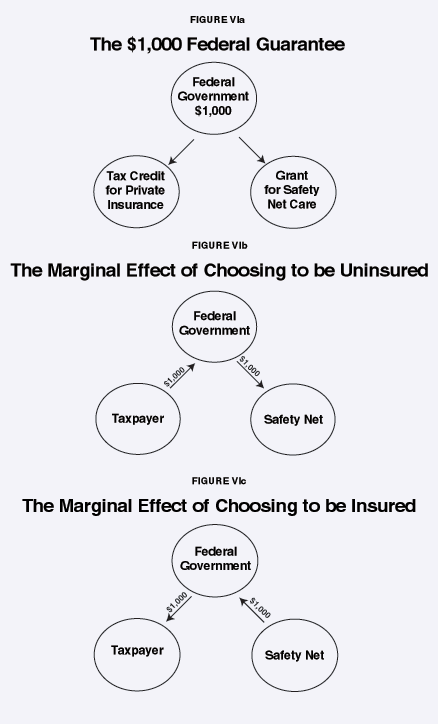
Think of the system that provides these services as "safety net insurance," and note that reliance on the safety net is not as valuable to patients as ordinary private insurance, other things equal. The privately insured patient has more choices of doctors and hospital facilities. Further, safety net care is probably much less efficient (e.g., using emergency rooms to provide care that is more economical in a free-standing clinic). As a result, per dollar spent the privately insured patient probably gets more care and better care.
Characteristic No. 4: The penalties paid by the uninsured should be used to compensate those who provide free care to the uninsured.
Characteristic No. 3 furnishes the basis for answering an important question: what should be done with the penalties collected from people who choose to remain uninsured? The answer: the funds should be used to compensate providers who give free care to the uninsured – no more and no less.12
As noted above, under the current system the uninsured pay higher taxes because they do not enjoy the tax relief given to those who have employer-provided insurance. These higher taxes are a "fine" for being uninsured. The problem is the extra taxes paid are simply lumped in with other revenues collected by the U.S. Treasury in Washington, D.C., while the expense of delivering free care falls to local doctors and hospitals.
Under an ideal system, the government would offer every individual a subsidy. If the individual obtained private insurance, the subsidy would be realized in the form of lower taxes (say, in the form of a tax credit). Alternatively, if the individual chose to be uninsured, the subsidy would be sent to a safety net agency in the community where the individual lives. [See Figure VIa]
One way to think of such an arrangement is to see it as a system under which the uninsured as a group pay for their own free care. That is, in the very act of turning down a tax credit (by choosing not to insure) uninsured individuals would pay extra taxes exactly equal to the average amount of free care given annually to the uninsured.13 [See Figure VIb]
Characteristic No. 5: The subsidies for the insured should, at the margin, be funded by reducing spending on free care for the uninsured.
"Subsidies for insurance should be funded by reducing spending on free care."
Point three also furnishes the basis for answering a related question: how should we fund the subsidies for those who choose to move from being uninsured to insured? The answer: at the margin, the subsidy should be funded by the reduction in expected free care that person would have consumed if uninsured – no more and no less.
Suppose everyone in Dallas County chose to obtain private insurance, relying, say, on a refundable $1,000 federal income tax credit to pay the premiums. As a result, Dallas County no longer would need to spend $1,000 per person on the previously uninsured. So all of the money that previously funded safety net medical care could be used to fund the private insurance premiums [See Figure VIc].
How could this scheme be implemented? Since much of the safety net expenditure already consists of federal funds, the federal government could use its share to fund private insurance tax credits instead. For the remainder, the federal government could reduce block grants to Texas for Medicaid and other programs.
One way to think about this arrangement is to see it as a system in which people who leave the social safety net and obtain private insurance actually furnish the funding needed to pay their private insurance premiums – at least at the margin. They do this by allowing public authorities to reduce safety net spending by an amount exactly equal to the private insurance tax subsidy.14
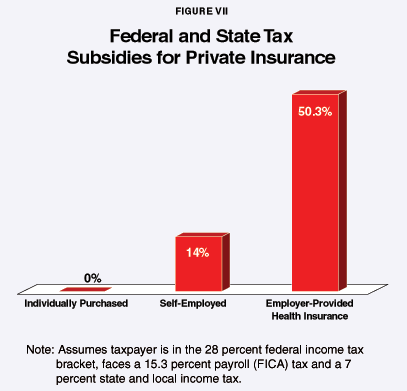
Characteristic No. 6: Subsidies for being insured should be independent of how the insurance is purchased.
The American health care system is largely an employer-based system, in which more than 90 percent of people with health insurance obtain it from an employer. In recent years many have questioned the wisdom of having employers choose health plans for their employees. Increasingly, there is interest in a system of personal and portable insurance in which individuals take their insurance with them as they travel from job to job and employers make defined-contribution premium payments to the plans their employees choose.
These issues should be resolved in the marketplace, rather than by the tax-writing committees of the U.S. Congress.
"The role of the employer should be determined in the marketplace."
Figure VII shows that a typical middle-income family with employer-provided coverage gets a tax subsidy equal to about half the cost of insurance. By contrast, families who purchase their own insurance get virtually no relief under the tax law. An ideal system would give the same tax relief, regardless of how the insurance is purchased [see Figure VIII]. If the playing field were level under tax law, the role of the employer would be determined through competition and choice in the marketplace.
Characteristic No. 7: The optimal number of uninsured is not zero.
"An ideal system would give the same tax relief, regardless of how the insurance is purchased."
The goal of health insurance reform is not to get everyone insured. (Indeed, everyone is already in a loose sense insured.) Instead, the goal is to reach a point at which we are socially indifferent about whether one more person obtains private insurance as an alternative to relying on the social safety net. That is the point at which the marginal cost (in terms of subsidy) to the remaining members of society of the last person we induce to insure is equal to the marginal benefit to the remaining members of society (in terms of the reduction in cost of free care). Once we satisfy this condition, it follows that the number of people who remain uninsured is optimal, and that number is not zero.
This is achieved by taking the average amount spent on free care and making it available for the purchase of private insurance. In our example, the government guarantees that $1,000 is available, depending on the choice of insurance system. From a policy perspective, we are indifferent about the choice people make.
Characteristic No. 8: The principles of reform apply with equal force to all citizens, regardless of income.
"The subsidy for being insured should be independant of income."
None of the first six points is in any way dependent for its validity on the income of the person who elects to be insured or uninsured. As a practical matter, one could argue that the high-income uninsured are likely to pay more out-of-pocket (get less free care) than the low-income uninsured, and therefore their subsidy/penalty should be smaller. Against that is the observation that high-income people (because of greater sophistication) are more adept overall at spending other people's money once they enter the health care system.
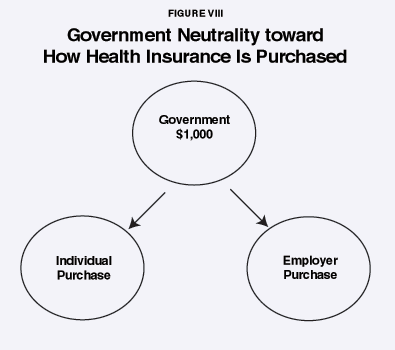
Waiving these considerations, a $100,000-a-year family can generate hospital bills it cannot pay almost as easily as a $30,000-a-year family. For that reason, our social interest in whether someone is insured is largely independent of income. For this reason as well as practical considerations, the tax credit should be independent of income.15
Characteristic No. 9: Health insurance subsidies need not add to budgetary outlays.
A common misconception is that health insurance reform costs money. For example, if health insurance for 40 million people costs $1,000 a person, some conclude that the government would need to spend an additional $40 billion a year to get the job done. What this conclusion overlooks is that we are already spending $40 billion or more on free care for the uninsured, and if all 40 million uninsured suddenly became insured they would – in that act – free up the $40 billion from the social safety net.
At more than one trillion dollars a year, there is no reason to believe our health care system is spending too little money. To the contrary, attempting to insure the uninsured by spending more money would have the perverse effect of contributing to health care inflation. As Gene Steuerle has shown, we can simply make some portion of people's tax liability contingent on proof of insurance.16 Getting all the incentives right may involve shifting around a lot of money – i.e., reducing subsidies that are currently too large and increasing subsidies that are too small. But it need not add to budgetary outlays. What follows are some possible ways of implementing this idea.
"There is no reason to believe our health care system is spending too little money."
Tax Subsidies for Middle-Income Taxpayers. For families who already pay substantial federal income taxes, the trick is to make some portion of tax liability contingent on proof of insurance. For example, the child credit (currently $500 per child, proposed to be $1,000 under President Bush's tax plan) could be tied to proof of insurance. Families that fail to provide proof would lose the credit and pay an additional $1,000 per child in taxes. Similarly, $1,000 of the personal exemption could also be tied to proof of insurance.
Tax Subsidies for Low-Income Taxpayers. Families with children and earning between, say, $10,000 and $30,000 a year generally qualify for the Earned Income Tax Credit (EITC). Even though they owe no income tax, these families can complete a tax return and get a "refund" from the Treasury, amounting to as much as $3,000 or $4,000 per year. The payments could be contingent on proof of insurance – whether through Medicaid, S-CHIP, an employer plan, or direct purchase.
Characteristic No. 10: The federal government's role should remain strictly financial.
Currently, the federal government "spends" more than $141 billion a year on tax subsidies for employer-provided insurance. However, there is virtually nothing in the tax code about what features a health insurance plan must have in order to qualify for a tax subsidy.17 Insurance purchased commercially, around two-thirds of the total, is regulated by the state governments. But the federal tax subsidy applies to whatever plans state governments allow to be sold.18
In this sense, the federal role is strictly financial. That is, the current tax break is based solely on the number of dollars taxpayers spend on health insurance, not on the features of the health plans themselves.
"There is no reason why government should dictate the content of health insurance plans."
This practice is sensible and should be continued. Aside from an interest in encouraging catastrophic insurance, there is no social reason why government at any level should dictate the content of health insurance plans. To continue our example, the role of the federal government should be to insure that $1,000 is available. It should leave the particulars of the insurance contract to the market, and it should leave decisions about how to operate the safety net health care to local citizens and their elected representatives.
[page]Reform of the U. S. health care system is less complicated than it at first might appear. The building blocks of an ideal system are already in place. The federal government already generously subsidizies private health insurance as well as safety net care. What is wrong with the current system is that there are too many perverse incentives.
One could reasonably argue that government is doing more harm than good, that a laissez faire policy would be better than what we have now.
"We should act quickly to replace perverse incentives."
Nonetheless, if government is going to be involved in a major way in our health care system we should act quickly to replace perverse incentives with neutral ones. In particular:
- At a minimum, government policy should be neutral between private insurance and the social safety net – never spending more on free care for the uninsured than it spends to encourage the purchase of private insurance.
- Government policy should also be neutral between individual and employer purchase – allowing the role of the employer to be determined by individual choice and competition in the market place.
If we applied these two principles and no others, we would go a long way toward creating an ideal health care system.
NOTE: Nothing written here should be construed as necessarily reflecting the views of the National Center for Policy Analysis or as an attempt to aid or hinder the passage of any bill before Congress.
[page]The author would like to acknowledge helpful comments from Ben Lytle, Gerald Musgrave, James Rodgers and Greg Scandlen.
- Robert J. Mills, Current Population Report, Health Insurance Coverage: 1999, P60-211, U. S. Census Bureau, September 2000.
- Jill M. Yegian et al., "The Nonpoor Uninsured in California, 1998," Health Affairs, July/August 2000.
- Melinda L. Schriver and Grace-Marie Arnett, "What States Can Teach Congress About Health Care Regulation, Heritage Foundation, Backgrounder No. 2107, July 23, 1998.
- John C. Goodman and Gerald L. Musgrave, "Freedom of Choice in Health Insurance," National Center for Policy Analysis, NCPA Policy Report No. 134, November 1988.
- Frank A. Sloan and Christopher J. Conover, "Effects of State Reforms on Health Insurance Coverage of Adults," Inquiry, Vol. 3 (1998), pp. 280-93.
- Gail A. Jensen and Michael A. Morrisey, "Mandated Benefit Laws and Employer-Sponsored Health Insurance," Health Insurance Association of America, January 1999.
- A group health plan can apply preexisting condition exclusions for no more than 12 months except in the case of late enrollees to whom exclusions can apply for 18 months.
- Health Care Financing and Organization: News and Progress, March 2000, pp. 5-6.
- American Health Line, March 31, 2000.
- Lewin Group estimates using the Health Benefits Simulation Model.
- There are many different ways to structure a subsidy. Although it is not the primary focus of this paper, an ideal subsidy would not distort decicions at the margin. That is, people should be able to choose on a level playing field between health care and nonhealth care and between health care today and health care tomorrow. See Mark V. Pauly and John C. Goodman, "Tax Credits for Health Insurance and Medical Savings Accounts," Health Affairs, Vol. 14, No. 1, pp. 126-39. Spring 1995.
- Low-income families who do not otherwise owe any federal income tax will not literally be paying their own way. But in foregoing, say, a $1,000 refundable tax credit they will be making a decision that allows the $1,000 to be deposited in a local safety net.
- To my knowledge, this idea as first proposed in John C. Goodman and Gerald L. Musgrave, Patient Power: Solving America's Health Care Crisis (Washington, D.C.: Cato Institute, 1992), pp. 641-45. For a similar approach, see Lynn Etheredge, "A Flexible Benefits Tax Credit for Health Insurance and More," Health Affairs Special Internet-only Publication, http://content.healthaffairs.org/cgi/reprint/hlthaff.w1.1v1.pdf
- Some patients may be high cost. In a private insurance market, insurers will not agree to insure someone for $1,000 if his or her expected cost of care is, say, $5,000. But if the safety net agency expects a $5,000 savings as a result of the loss of a patient to a private insurer, the agency should be willing to pay up to $5,000 to subsidize the private insurance premium.
- We can readily grant that there is no social reason to care whether Bill Gates is insured. So there could be an income or wealth threshold, beyond which the subsidy/penalty system does not apply. However, as a practical matter there are so few individuals that would qualify for an exemption that uniform treatment for everyone is administratively attractive.
- C. Eugene Steuerle, "Child Credits: Opportunity at the Door," Urban Institute, 1997.
- The exceptions are mandated maternity coverage in most health plans, and federal mandates requiring a 48 hour hospital stay after a well-baby delivery if requested by a patient and physician and mandated mental health parity.
- M. Susan Marquis and Stephen H. Long, "Recent Trends in Self-Insured Employer Health Plans," Health Affairs, Vol. 18, No. 3, May/June 1999, pp. 161-66.
John C. Goodman is President of the National Center for Policy Analysis. Dr. Goodman earned his Ph.D. in economics at Columbia University and has engaged in teaching and research at six colleges and universities, including Columbia University, Stanford University, Dartmouth College, Sarah Lawrence College and Southern Methodist University. Dr. Goodman has written widely on health care, Social Security, privatization, the welfare state and other public policy issues. He is the author of seven books and numerous scholarly articles. Dr. Goodman's published works include National Health Care in Great Britain, Regulation of Medical Care: Is the Price Too High?, Economics of Public Policy, Social Security in the United Kingdom and, with Gerald L. Musgrave, Patient Power: Solving America's Health Care Crisis.